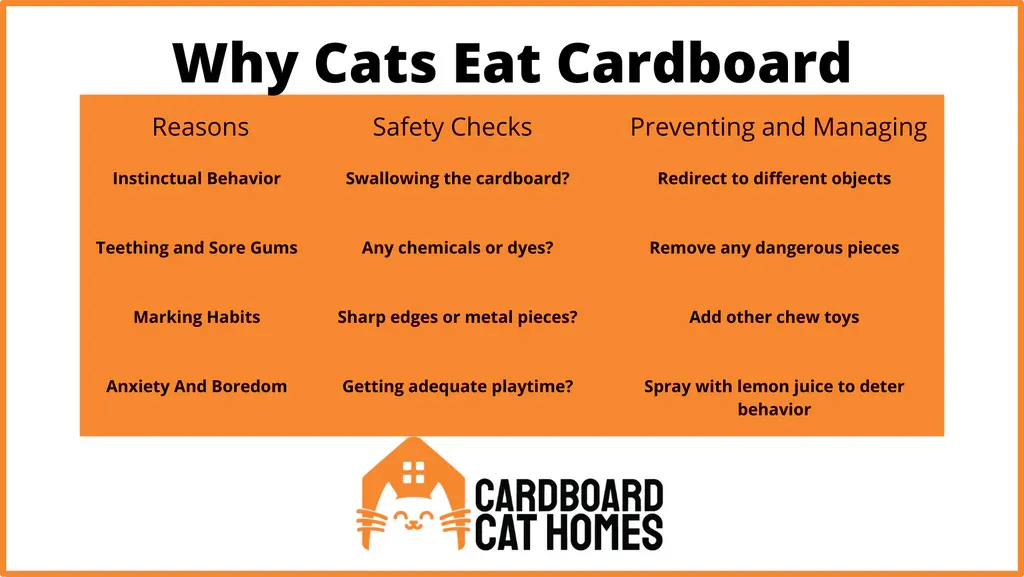Cats are fascinating pets known for their playful antics and quirky behaviors. If you’ve noticed your cat obsessively chewing on cardboard, you’re not alone—many cat owners report this habit. Whether it’s shredded boxes or flattened scraps, why does my cat chew on cardboard? This behavior stems from instinctual drives, health issues, or environmental factors. Understanding the reasons can help you address it effectively while keeping your feline safe.
In this guide, we’ll explore the common causes, assess if it’s normal and safe, and share practical prevention strategies. Drawing from veterinary insights and real cat owner experiences, you’ll learn how to manage this without frustration.
 infographic cats eating cardboard explained
infographic cats eating cardboard explained
Common Reasons Why Cats Chew on Cardboard
Cats chew cardboard for several instinctual and practical reasons. Recognizing these can prevent escalation into problematic habits.
Natural Predatory Instincts
Cats are born hunters, and cardboard mimics prey textures and sounds. The crinkly noise and rough surface trigger their curiosity, prompting biting and scratching. According to the ASPCA, this exploratory behavior helps satisfy predatory instincts, much like kittens teethe on soft objects. Adult cats may continue if their environment lacks stimulation, turning boxes into makeshift hunt zones.
Veterinarians note that providing interactive toys can channel this energy safely, reducing unwanted chewing.
Teething and Potential Health Issues
Kittens often chew during teething as adult teeth emerge around 3-6 months, soothing sore gums. For adults, persistent chewing might signal pica—a condition linked to nutritional deficiencies, anemia, or thyroid problems. The International Cat Care organization highlights that inflamed gums from dental disease can also drive this.
If your cat swallows pieces or shows lethargy, consult a vet promptly. Early blood tests can rule out underlying issues, ensuring timely treatment.
Territorial Marking Behaviors
Cats mark territory by rubbing cheeks or chewing objects, depositing pheromones. Cardboard’s porous surface absorbs scents effectively, making it appealing. Hartz Pet Experts explain this as a natural claiming ritual, similar to scratching posts.
While harmless in moderation, excessive marking might indicate stress from new pets or moves. Observe patterns to differentiate play from anxiety.
If boredom contributes, similar to when my cat is constantly meowing, enrich their space with climbing shelves.
Boredom and Stress Relief
Indoor cats prone to boredom seek outlets like cardboard for sensory fun. The texture under paws and shredding satisfaction provides mental stimulation. Cornell University’s Feline Health Center links destructive chewing to insufficient playtime or environmental changes.
Owners report success with puzzle feeders or daily 15-minute sessions using feather wands. Rotate toys to maintain interest, preventing habits like this.
Is It Normal for Cats to Chew Cardboard?
Yes, occasional chewing is normal and engaging for most cats due to the satisfying crunch and texture. It’s a self-soothing activity, especially for playful breeds like Siamese. However, if it becomes obsessive—chewing for hours or ignoring food—monitor closely. Vets consider it typical instinct unless paired with weight loss or vomiting.
Experienced owners note it’s common in multi-cat homes, where boxes serve as social hubs.
Is Chewing Cardboard Safe for Cats?
Generally safe if limited to chewing without ingestion, but risks exist. Untreated cardboard lacks toxins, unlike taped or printed boxes with inks and glues.
Prevent Swallowing Large Pieces
Swallowed fragments risk intestinal blockages, per the ASPCA Animal Poison Control Center. Pica exacerbates this; redirect with soft toys if ingestion occurs. Watch for vomiting, diarrhea, or constipation—emergency signs requiring vet care.
Steer Clear of Chemicals and Hazards
Avoid waxed, chemical-treated, or sharp-edged cardboard. Staples or glossy coatings can irritate stomachs. Opt for plain, clean scraps and supervise play.
In one case shared on veterinary forums, a cat recovered fully after mild blockage surgery from glued box pieces—prevention is key.
If stress-related chewing persists, check if your cat always meowing signals similar needs.

How to Prevent Your Cat from Chewing Cardboard
Proactive steps redirect energy effectively, minimizing risks.
Redirect to Appropriate Alternatives
Don’t punish—interrupt gently and offer catnip mice or sisal scratchers. Positive reinforcement with treats builds new habits. Train with clickers for quick results, as recommended by the American Association of Feline Practitioners.
Limit Access to Cardboard
Store boxes in closed cabinets or recycle promptly. Create designated play zones with approved destructibles like paper bags.
Use Deterrents Sparingly
Bitter sprays (pet-safe formulas) or double-sided tape make cardboard unappealing. A light water spritz works for some, per The Spruce Pets, but pair with enrichment to address roots.
For hiding behaviors tied to anxiety, explore why your cat hiding from me.
Consistency yields results in 1-2 weeks.
Final Thoughts on Cat Cardboard Chewing
Chewing cardboard reflects your cat’s natural instincts, from hunting drives to boredom relief, but monitor for health red flags like pica or dental pain. By enriching their world with toys, routine play, and safe outlets, you can curb it humanely.
Prioritize vet check-ups for persistent issues and maintain a stimulating home. Your cat will thrive with these tweaks.
Share your stories below—has cardboard chewing been a challenge? For more feline tips, read about when my cat stopped meowing.
 Cat scratching surface on cardboard home
Cat scratching surface on cardboard home
References
- ASPCA: Predatory Instincts in Cats
- International Cat Care: Pica in Cats
- Cornell Feline Health Center: Destructive Behavior
- Hartz: Territorial Marking
